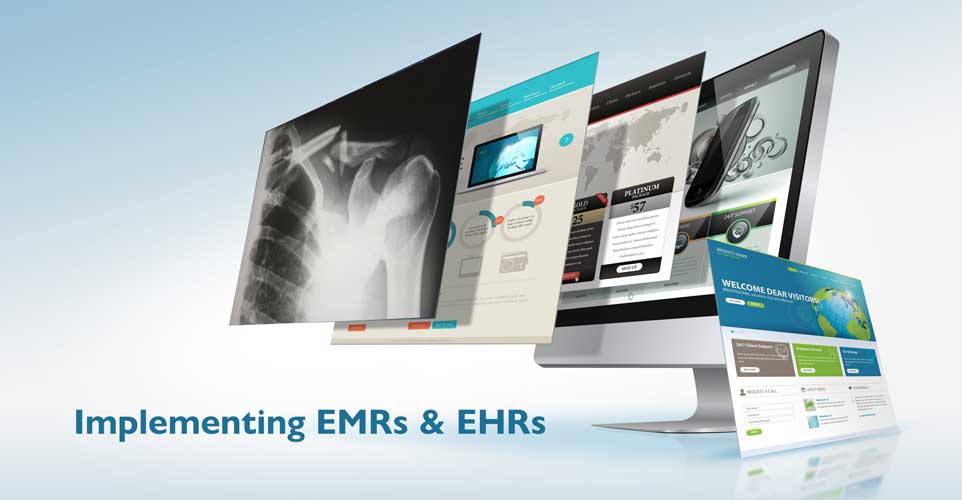
Implementing Electronic Medical Records (“EMR”) Software for Small Healthcare Organizations
- January 9, 2020
- 4:22 pm
- Medical, Medical Equipment, Software
In order to comply with the HIMSS EMRAM, many hospitals are adopting EMRs in order to move their organization closer to achieving a paperless environment and improve the quality of patient care. Many doctor’s offices, clinics, and managed care facilities are going to EMRs or EHRs because of the convenience of going to paperless recordkeeping.
Also, many healthcare facilities are trying to improve the patient satisfaction levels and having an EHR or EMR is a big part of their solution. By allowing hospitalized patients to review their charts, order their dinner, access the internet or watch TV via electronic means, it improves the overall patient experience, particularly for extended hospital stays.
Adopting electronic medical records comes with its own set of problems. It can take months or even years to fully incorporate or update an EMR system depending upon the size of your organization and the level of HIMSS compliance that you wish to attain. It can also come with a large price tag.
Implementation is An Expensive Process
A major issue with EMR software is how expensive it can be. Implementing a full system for an EMR can cost over $150,000 for just one physician. The total cost, of course, grows much more expensive the larger the medical facility and the more advanced the software and hardware.
Because of this, it’s important for any medical facility looking to implement an EMR system to consider the high cost into their budget. Not only is the upfront cost of implementing such a system high, but it needs to be maintained and occasionally updated to keep in line with the latest regulations.
So, it’s imperative that these costs be taken into consideration when managing an EMR system for any medical organization, whether it be a large hospital or a small physician’s office.
Required Training
Another important thing to keep in mind with any EMR system is the training that is required to use them. This training includes medical personnel & doctors as well as staff. It can involve a whole new system of doing things within the healthcare organization when they move from paper to computerized records. It can take many months and sometimes years in order to completely implement an EMR system.
This creates yet another cost that must be factored in when considering the budget for the EMR system as well as a hurdle that needs to be overcome before the system can even be used in the first place.
Cutting Edge Software and Hardware
When moving from paper medical records to electronic records, most healthcare organizations will need new hardware, security and IT personnel. This can be a large investment. The computers will need to have the capacity to run the EMR software and any patient satisfaction software. You’ll want computers that are able to do double-duty: be used by the doctors and staff to enter information and, for patients who have overnight stays, a patient engagement platform so that they have a good experience with the hospital or healthcare facility.
Additionally, for many healthcare organizations, it’s likely that it will need tablet PCs with scanners in order to scan prescriptions, patient wrist bracelets, and implement other patient tracking requirements.
There are also security concerns with electronic records including HIPAA requirements that means investing in security technology and IT personnel.
All this adds up to a substantial investment in new hardware and personnel.
Options for Small to Medium-Sized Facilities
Many smaller healthcare organizations can’t afford the substantial upfront costs of implementing an EMR system. The solution to this is to finance the upfront costs and the subscription itself. This allows the organization to pay for the EMR and its implementation in monthly payments over an extended timeframe which is much more manageable.
However, the decision to finance an EMR needs considerable attention as there are a lot of factors involved, including deciding on a finance company, determining how money needs to be financed, and factoring in the monthly payment along with all the other monthly costs that the organization must budget.
Fortunately there are companies with specific expertise in the financing of EMR/EHR solutions that can work directly with busy practices to help them create a financing program that meets their objectives and enables a simple, easy and efficient solution that enables all of the various costs of engagement to be aggregated together with one monthly payment over a term that meets budgeting requirements.
One of the primary goals of the practice when considering the EMR/EHR acquisition is the ability to conserve their working capital and not disturb existing banking lines of credit. For that reason, many healthcare professionals have relied on financing programs and have found that results in the most economically feasible approach for moving forward.
Further, there might well be Section 179 tax benefits available when selecting to finance this important technology.
Recent Posts
- Bonus Depreciation is About to Phase Down to 80% in 2023 December 29, 2022
- Tax Benefits of Buying Equipment & Software Before December 31, 2022 December 8, 2022
- How the Inflation Reduction Act Impacts your Business and You and your Family August 16, 2022
- Recession? What Recession? July 27, 2022
- Dimension Funding Has Paperless Financing April 26, 2022
